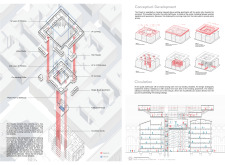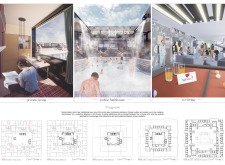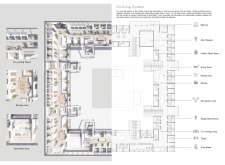5 key facts about this project
The Clouds co-living bathhouse prototype located in Rome integrates living spaces and communal facilities in a city rich with history. The design focuses on reimagining co-living by incorporating a central bathhouse that serves not only as a shared amenity but also as a gathering place for residents. The architecture creates a connection between existing buildings and new structures, emphasizing both community and functionality.
Design Concept
The design includes four key elements: two raised co-living rings and central cores that allow access to the bathhouse. This arrangement enhances interaction among residents while maintaining distinct spaces for private living. The overall shape of the building acts like a funnel, directing rainwater collected from surrounding rooftops into trenches that lead to the bathhouse. This method supports sustainable water management principles.
Spatial Configuration
By elevating the co-living units above existing structures, the design offers both separation and connection. It allows residents privacy within their own spaces while encouraging interaction in communal areas. The central bathhouse helps link new residents with those already living in the community, fostering a sense of inclusion and shared experience.
Community Engagement
At the heart of the design is the public bathhouse, reflecting an aspect of Roman culture that emphasizes public bathing as a social activity. The reintroduction of this tradition aims to strengthen community ties and create opportunities for residents to meet and bond. Exterior walkways ensure easy access and movement between different levels of the development, enhancing the sense of community.
Sustainable Practices
A key feature is the focus on sustainability within the design. The rainwater collection system shows a commitment to responsible resource management, allowing the bathhouse to operate efficiently while minimizing waste. This sustainable aspect supports the overall functionality of the design and aligns with modern environmental standards.
The Clouds serves as a thoughtful response to contemporary urban living, balancing private needs with communal aspirations. Its attention to form, function, and community makes it a relevant addition to Rome's architectural landscape, while paying homage to the city’s historical context.





















































